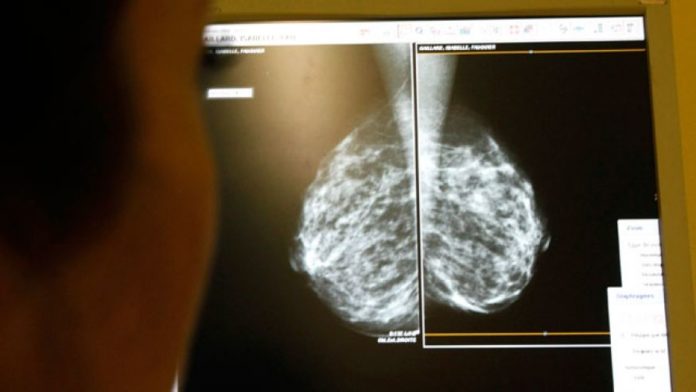
In an exciting new study, researchers from the Women & Infants Hospital of Rhode Island describe a major advancement in cancer therapy that could lead to significant improvements in outcomes for women with triple-negative breast cancer, an aggressive form of the disease that disproportionately affects younger women.
“Impact of the Addition of Carboplatin and/or Bevacizumab to Neoadjuvant Once-Per-Week Paclitaxel Followed by Dose-Dense Doxorubicin and Cyclophosphamide on Pathologic Complete Response Rates in Stage II to III Triple-Negative Breast Cancer: CALGB 40603 (Alliance)” was accepted as a rapid publication and published online this month by the Journal of Clinical Oncology. It will come out in print in September.
Breast cancer is the most common cancer among women in the United States, the second most common cause of cancer death, and the main cause of death in women ages 45 to 55 years. In 2011, more than 220,000 women in the U.S. were diagnosed with breast cancer, and about one in five died of the disease.
Treatment of breast cancer differs by patient due to variations in tumor characteristics: While some tumors contain protein receptors that are activated by the hormones estrogen or progesterone, others respond to another protein called human epidermal growth factor receptor 2, or HER2. Each of these is treated differently.
However, some breast cancers test negative for both hormone receptors and HER2 in the lab, which means they are triple-negative. Since hormones are not supporting its growth, the cancer is unlikely to respond to hormonal therapies, including tamoxifen; it is also is unlikely to respond to medications that target HER2, such as Herceptin or Tykerb. Triple-negative breast cancers are generally more aggressive and more likely to recur than other breast cancers.
Because of its rapid growth rate, many women with triple-negative breast cancer receive chemotherapy to try to shrink the tumor before undergoing surgery. With the standard treatment, the cancer is eliminated from the breast and lymph nodes in the armpit before surgery in about one third of women. This is referred to as a pathologic complete response (pCR). In patients who achieve pCR, the cancer is much less likely to come back, spread to other parts of the body, or lead to death than if the cancer survives the chemotherapy.
“Overall prognosis for women with this type of breast cancer remains inferior to that of other breast cancer subtypes, with higher risk of early relapse,” says lead author Dr. William M. Sikov, a medical oncologist in the Breast Health Center and associate director for clinical research in the Program in Women’s Oncology at Women & Infants Hospital of Rhode Island.
Adding carboplatin to chemotherapy may boost chances of achieving pCR
In the new study, Dr. Sikov and colleagues investigated the addition of other drugs — carboplatin and/or bevacizumab — to the standard treatment regimen to see if they could increase treatment response rates. More than 440 women with stage II or III triple-negative breast cancer enrolled in the randomized clinical trial.
As a pre-surgery treatment, the women were randomly assigned to receive either standard chemotherapy (a combination of paclitaxel, adriamycin, and cyclophosphamide), standard chemotherapy plus carboplatin, standard chemotherapy plus Avastin (a drug that blocks cancers from generating blood vessels), or standard chemotherapy plus both carboplatin and Avastin.
The team found that adding either of these medications significantly increased the percentage of women who achieved a pCR with the preoperative treatment. Among patients who received standard chemotherapy alone, 34 percent had their tumors disappear. That compares with 48 percent of patients in the chemotherapy plus carboplatin group, 51 percent those in the chemotherapy plus Avastin group, and 61 percent of those in the chemotherapy plus carboplatin and Avastin group.
Of the two agents they studied, the researchers say they are more encouraged by the results from the addition of carboplatin, which was associated with fewer and less concerning additional side effects than bevacizumab.
Promising as the results are, “more research is needed to determine which women with triple-negative breast cancer particularly benefit from added carboplatin and which do not,” says Dr. Sikov. “As we learn more about triple-negative breast cancer, we’ll be better able to determine which set of drugs is most effective for individual patients.”
“We hope that this means fewer women will relapse and die of their cancer,” he adds.
Dr. Sikov and colleagues have already planned more studies to confirm the role of carboplatin in women with triple-negative breast cancer, and also to see if they can better identify which of these patients are most likely to benefit from its use. “Until we have those results, medical oncologists who treat women with triple-negative breast cancer will have to decide whether the potential benefits of adding carboplatin outweigh its risks for each individual patient,” says Dr. Sikov.
Triple-negative breast cancer accounts for 15 to 20 percent of invasive breast cancers diagnosed in the United States each year, and is more common in younger women, African-Americans, Hispanics, and BRCA1-mutation carriers. With no identified characteristic molecular abnormalities that can be targeted with medication, the current standard of treatment is chemotherapy.
While treatment options remain limited for women with triple negative breast cancer, scientists have made a number of recent discoveries that could open the door for entirely new approaches to treating the disease. In one particularly innovative study published in June, researchers from Penn State College of Medicine found that Adeno-associated virus type 2 (AAV2) — a virus that infects humans but is not known to cause sickness — can kill triple-negative breast cancer cells in mice. The virus initiated apoptosis — natural cell death — in cancer cells without affecting healthy cells. Furthermore, the virus also killed tumors grown from these cells in mice. The researchers are hopeful that insights from this discovery will eventually lead to more targeted treatments for the aggressive cancer.
